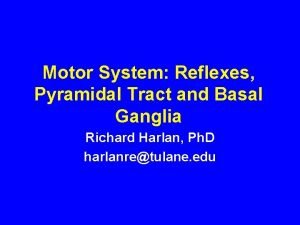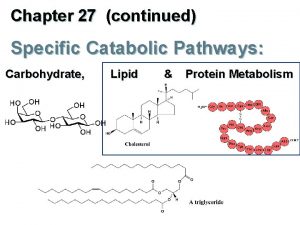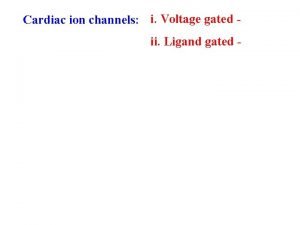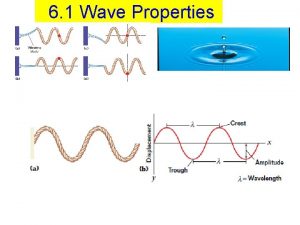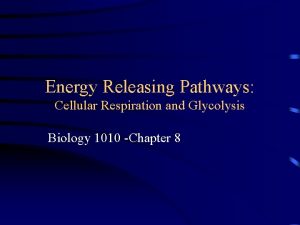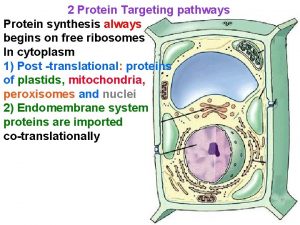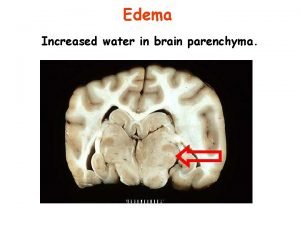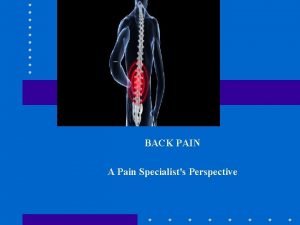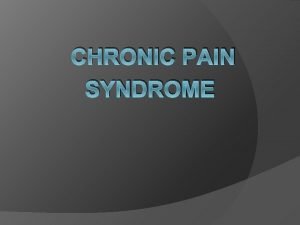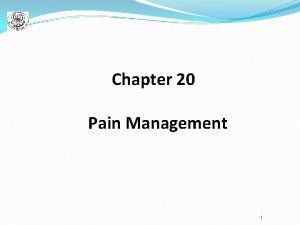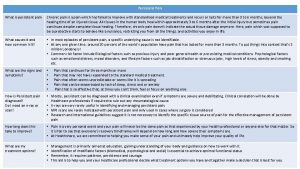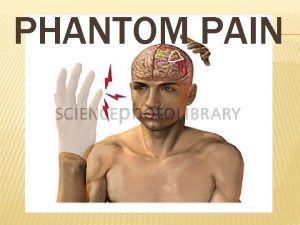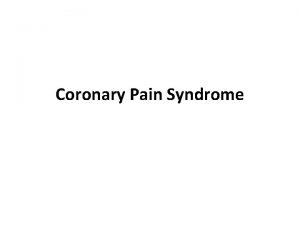pain h Dr Jarahzade Intensivis Pain Pathways and



































































- Slides: 67


ﺩﺭﺩ pain h Dr. Jarahzade Intensivis




Pain Pathways and the Neurobiology of Nociception Surgery produces tissue injury with consequent release of histamine and inflammatory mediators, such as peptides (bradykinin), lipids (prostaglandins), neurotransmitters (serotonin), and neurotrophins (nerve growth factor). The release of inflammatory mediators activates peripheral nociceptors, which initiate transduction and transmission of the nociceptive information to the central nervous system (CNS) and the process of neurogenic inflammation in which release of neurotransmitters (substance P and calcitonin gene-related peptide) in the periphery induces vasodilatation and plasma extravasation

Noxious stimuli are transduced by the peripheral nociceptors and transmitted by A 8 and C nerve fibers from peripheral visceral and somatic sites to the dorsal horn of the spinal cord, where integration of peripheral nociceptive and descending modulatory input (serotonin, noradrenaline, and en kephalin)occurs. Further transmission of nociceptive information is determined by complex modulating influences in the spinal cord. Some impulses pass to the anterior and anterolateral horns to initiate segmental (spinal) reflex responses, (increased skeletal muscle tone, inhibition of phrenic nerve function or even decrease gastrointestinal motility).

Others are transmitted to higher centers through the spinothalamic and spinoreticular tracts, where they produce suprasegmental and cortical descending. responses to ultimately produce the perception of pain. modulator input Continuous release of inflammatory mediators in the periphery sensitizes functional nociceptors and activates dormant ones. Sensitization of peripheral nociceptors may occur and is marked by a decreased threshold for activation, increased discharge rate with activation, and increased rate of basal (spontaneous) discharge. Intense noxious input from the periphery may also result in central sensitization ("persistent post injury changes in the. CNS that result in pain hypersensitivity"ll) and hyperexcitability("exaggerated and prolonged responsiveness of neurons to normal afferent input after tissue damage).

Such noxious input may lead to functional changes in the dorsal horn of the spinal cord and other consequences that may later cause postoperative pain to be perceived as more painful than it would otherwise have been. The neural circuitry in the dorsal horn is extremely complex, and we are just beginning to elucidate the specific role of the various neurotransmitters and receptors in the process of nociception. However, it seems that certain receptors (N-methyl-o-aspartate [NMDA])may be especially important for the development of chronic pain after an acute injury although others (substance P, protein kinase C-y) may also piay important roles in spinal cord sensitization and chronic pain.


Experimental studies show that noxious stimuli can produce expression of new genes(which are the basis for neuronal sensitization)in the dorsal horn of the spinal cord within 1 hour and that these changes are sufficient to alter behavior within the same time frame. Clinical studies also suggest that the intensity of acute postoperative pain is a significant predictor of chronic postoperative pain. Control of acute postoperative pain and the timing, duration (preemptive analgesia), and fashion in which it is implemented (multimodal perioperative management) may be important in acilitating short- and long-term patient convalescence after surgery

Acute and Chronic Effects of Postoperative. Pain Uncontrolled postoperative pain may produce a range of detrimental acute and chronic effects. Attenuation of peri operative pathophysiology that occurs during surgery through reduction of nociceptive input into the CNS and optimization of peri operative analgesia may decrease complications and facilitate the patient's recovery during the immediate postoperative period and after discharge from the hospital.

Acute Effects Uncontrolled peri operative pain may potentiate some of these perioperative pathophysiologies and increase morbidity and mortality for patients. Attenuation of postoperative pain, especially using certain types of analgesic regimens, may decrease perioperative morbidity and mortality. The transmission of nociceptive stimuli from the periphery to the CNS results in the neuroendocrine stress response, a combination of local inflammatory substances(cytokines, prostaglandins, leukotrienes) and systemic mediators of the neuroendocrine response. The dominant neuroendocrine responses to pain involve hypothalamicpituitary- adrenocortical and sympathoadrenal interactions.

Suprasegmental reflex responses to pain result in increased sympathetic tone, increased catecholamine and catabolic hormone secretion ( cortisol, adrenocorticotropichormone, antidiuretic hormone, glucagon, aldosterone, renin, angiotensin II), and decreased secretion of anabolic hormones The effects include sodium and water retention and increased levels of blood glucose, free fatty acids, ketone bodies, and lactate. A hypermetabolic, catabolic state occurs as metabolism and oxygen consumption are increased and metabolic substrates are mobilized from storage depots

Attenuation of the stress response and postoperative pain may facilitate and accelerate the patient's recovery post operatively. The neuroendocrine stress response may potentiate detrimental physiologic effects in other areas of the body. The stress response may be an important factor in the postoperative development of hypercoagulability. Enhancement of coagulation (decreased levels of natural anticoagulants and increased levels of procoagulants), inhibition of fibrinolysis, and increased platelet reactivity and plasma viscosity may contribute to an elevated incidence of postoperative hypercoagulablerelated events such as deep venous thrombosis, vascular graft failure, and myocardial ischemia.

The stress response also may potentiate postoperative immunosuppression, the extent of which correlates to the severity of surgical injury. Hyperglycemia from the stress response may contribute to poor wound healing and depression of immune function. Uncontrolled postoperative pain may activate the sympathetic nervous system, which may contribute to morbidity or mortality. Sympathetic activation may increase myocardial oxygen consumption, which may be important in the development of myocardial ischemia and infarction. Sympathetic activation may decrease myocardial oxygen supply through coronary vasoconstriction and attenuation of local metabolic coronary vasodilation. Sympathetic activation may also delay return of postoperative gastrointestinal motility that may develop into paralytic ileus.

Postoperative respiratory function is markedly decreased, especially after upper abdominal and thoracic surgery. Spinal reflex inhibition of phrenic nerve activity is an important component of this decreased postoperative pulmonary function. However, control of postoperative pain is also important, because patients with poor pain control may breathe less deeply, have an inadequate cough, and may be more likely to develop postoperative pulmonary complications. Nociceptor activation may also initiate a spinal reflex inhibition of gastrointestinal tract function and delay return of gastrointestinal motility.

Chronic Effects. Poorly controlled acute postoperative pain may be an important predictive factor in the development of pathologic long-term chronic pain after surgery. the transition from acute to chronic pain occurs very quickly and that long-term behavioral and neurobiologic changes occur much earlier than previously anticipated. Chronic pain is relatively common after procedures such as limb amputation (30% to 83%), thoracotomy (22%to 67%), sternotomy (27%) breast surgery (11% to 57%), and gallbladder surgery(up to 56%). Prevention of central sensitization and control of postoperative pain may decrease the incidence of chronic pain. Postoperative chronic pain that develops as a result of poor postoperative pain control may interfere with patients' activities of daily living.

Preemptive Analgesia Development of central sensitization and hyperexcitability occurs after surgical incision and results in the amplification of postoperative pain. Preventing the establishment of altered central processing by analgesic treatment may result in short-term (reduction in postoperative pain and accelerated recovery) and long-term (reduction in chronic pain and improvement in HRQL) benefits during a patient's convalescence. Definitions of preemptive analgesia include *what is administered before surgical incision, what prevents establishment of central sensitization resulting from incisional injury only (intraoperative period), *what prevents central sensitization resulting from incisional and inflammatory injuries (intraoperative and postoperative period). Incisional and inflammatory injuries are important in initiating and maintaining central sensitization. Confining the definition of preemptive analgesia to only the intraoperative (incisional) period may not be clinically relevant or appropriate because the inflammatory response may last well into the postoperative period and continue to maintain central sensitization. By preventing central sensitization, preemptive analgesia along with intensive multimodal analgesic interventions may reduce acute postoperative pain and chronic pain after surgery.

Multimodal Perioperative Management The analgesic benefits of controlling postoperative pain are generally maximized when a multi modal strategy to facilitate the patient's convalescence is Implemented. Principles of a multimodal strategy include control of postoperative pain of the patient to allow early mobilization, early enteral nutrition, education, and attenuation of the perioperative stress response through the use of regional anesthetic techniques and a combination of analgesic agents (multimodal analgesia). The use of epidural anesthesia and analgesia is an integral part of the multimodal strategy because of the superior Analgesia and physiologic benefits conferred by epidural analgesia. A multi modal strategy to control postoperative pathophysiology and facilitate rehabilitation results in accelerated recovery and decreased length of hospitalization Patients undergoing major abdominal or thoracic procedures and who participate in a multimodal strategy have a reduction in hormonal and metabolic stress, preservation of total-body protein, shorter times to extubation, lower pain scores, earlier return of bowel function, and earlier fulfillmen of intensive care unit discharge

TREATMENT METHODS Many options are available for the treatment of postoperative pain, including systemic (opioid and nonopioid)analgesics and regional (neuraxial and peripheral) analgesic techniques. By considering patients' preferences and an individualized assessment of the risks and benefits of each treatment modality, the clinician can optimize the postoperative analgesic regimen for each patient. Essential aspects for postoperative monitoring for patients receiving various postoperative analgesic treatment methods are listed in Table 72 -1. 2


Systemic Analgesic Techniques Opioid analgesics are one of the cornerstone options for the treatment of postoperative pain. These agents generally exert their analgesic effects through mu receptors in the CNS, although there is evidence that opioids may also act at peripheral opioid receptors. analgesic efficacy of opioids is typically limited by the development of tolerance or opioid-related side effects such as nausea, vomiting, sedation, or respiratory depression. Opioids may be administered by subcutaneous, transcutaneous, and transmucosal routes, the most common routes of postoperative systemic opioid analgesic administration are oral, intravenous, and intramuscular. Opioids also may be administered at specific anatomic sites such as the intrathecal or epidural space. Certain routes of administration (intramuscular) may result in a wider variability in serum drug concentrations than other routes (intravenous).

In general, opioids are administered parenterally (intravenously or intramuscularly) for the treatment of moderate to severe postoperative pain, in part because these route provide a more rapid and reliable onset of analgesic action than the oral route. Parenteral opioid administration may be necessary in patients who are unable to tolerate oral intake postoperatively. The transition from parenteral to oral administration of opioids usually occurs after the patient initiates oral intake and postoperative pain has been stabilized with parenteral opioids Transdermal fentanyl has been used for acute pain management, but transdermal fentanyl cannot be easily titrated,

Intravenous Patient-Controlled Analgesia Various factors, including the wide interpatient and intrapatient variability in analgesic needs, variability in serum drug levels (especially with intramuscular injections), and administrative delays may contribute to inadequate postoperative analgesia. intravenous patient-controlled analgesia (PCA) optimizes delivery of analgesic opioids and minimizes the effects of pharmacokinetic and pharmacodynamic variability among individual patients. Intravenous PCA is based on the premise that a negative-feedback loop exists; when pain is experienced, analgesic medication is self-administered, and when pain is reduced, there are no further demands. When the negative-feedback loop is violated, excessive sedation or respiratory depression may occur and most problems related to PCA use result from user or operator errors. A PCA device can be programmed for several variables, including the demand (bolus) dose, lockout interval, and background infusion. The optimal demand or bolus dose is integral to intravenous PCA analgesic efficacy because an insufficient demand dose may result in inadequate analgesia, whereas an excessive demand dose may result in a higher incidence of undesirable side effects such as respiratory depression.

Although the optimal demand dose is uncertain, available data suggest that the optimal demand dose for morphine is 1 mg and that for fentanyl is 40 micg for opioidnaive patients; however, the actual dose for fentanyl (10 to 20 micg) is often less in clinical practice. The lockout interval may also affect the analgesic efficacy of intravenous PCA. A lockout interval that is too long may result in inadequate analgesia and decrease the analgesic effectiveness of intravenous PCA. A lockout interval that is too short allows the patient to self-administer another demand dose before feeling the full analgesic effect of the previous dose and may contribute to an increase in medication-related side effects. The lockout interval is a safety feature of intravenous PCA and, although the optimal lockout interval is unknown, most intervals range from 5 to 10 minutes, and varying the interval within this range appears to have no effect on analgesia or side effects. Most PCA devices allow the addition of a continuous or background infusion in addition to the demand dose.

Use of a night time background infusion does not improve postoperative sleep patterns, analgesia, or recovery profiles. so Although the routine use of continuous or background infusions in intravenous PCA in adult opioid-naive patients is not recommended, there may be a role for use of a background infusion for opioidtolerant or pediatric patients Compared with traditional PRN analgesic regimens, intravenous PCA provides superior postoperative analgesia, improves patient satisfaction, and may decrease the risk of pulmonary complications; it is not clear whether intravenous PCA is superior to traditional PRN intramuscular opioid administration because the calculations of cost are complex. Although here appears to be no improvement in hospital length of stay with intravenous PCA, intravenous PCA does require less nursing time than intramuscular injections, which may be important with the shift toward using a higher percentage of less-skilled providers on surgical wards.

Patients tend to prefer intravenous PCA compared with intravenously, intramuscularly, or subcutaneously Greater patient satisfaction with intravenous PCA may be the result of superior analgesia and of perceived control over analgesic medication administration and avoidance of disclosing pain or securing analgesic medication from nurses. ' The incidence of opioid-related side effects from intravenous PCA does not appear to differ significantly from that administered intravenously, intramuscularly, or subcutaneously. The rate of respiratory depression associated with intravenous PCA is low and does not appear to be higher than that with systemic or neuraxial opioids Factors that may be associated with occurrence of respiratory depression with intravenous PCA include use of a background infusion, advanced age, concomitant administration of sedative or hypnotic agents, and coexisting pulmonary disease such as sleep apnea. The incidence of nocturnal hypoxemia in patients receiving intravenous PCA may be reduced with supplemental oxygen administration.

Nonopioid Analgesics NSAIDs Which include aspirin and acetaminophen, consist of a diverse group of analgesic compounds with different pharmacokinetic properties. The primary mechanism by which NSAIDs exert their analgesic effect is through the inhibition of the cyclooxygenase (COX) and synthesis of prostaglandins, which are important mediators for peripheral sensitization and hyperalgesia. NSAIDs can also exert their analgesic effects through inhibition of spinal. COX. The discovery of at least two COX isoforms ( COX-l is constitutive, and COX-2 is inducible) with different functions. COX-l participates in platelet aggregation, hemostasis, and gastric mucosal protection, and COX-2 participates in pain, inflammation, and fever has led to the development of selective COX-2 inhibitors that differ from traditional NSAIDs, which block COX-1 and COX_2. The discovery of a COX-3 variant may represent a primary central mechanism by which acetaminophen and other antipyretics decrease pain and fever. Used as sole agents, NSAIDs generally provide effective analgesia for mild to moderate pain. NSAIDs also are traditionally considered a useful adjunct to opioids for treatment of moderate to severe pain,

NSAIDs may be administered orally or parenterally and are particularly useful as components of a multimodal analgesic regimen that reducing opioid analgesic requirements, decreasing opioid-related side effects, and facilitating NSAl. Ds can improve postoperative analgesia and reduce opioid requirements up to 50% , Use of NSAl. Ds may facilitate by return of gastrointestinal function, reduce nausea, decrease respiratory depression, and improve patient satisfaction, NSAID use Despite the analgesic benefits, perioperative use of NSAIDs is associated with a number of side effects, including decreased hemostasis, renal dysfunction, gastrointestinal hemorrhage, and effects on bone healing and osteogenesis. . Decreased hemostasis from NSAID use is attributed primarily to platelet dysfunction and inhibition of thromboxane A 2 (generated by COX-I), which is an important mediator of platelet aggregation and vasoconstriction.

Perioperative NSAID-induced renal dysfunction may occur in high-risk patients, such as those with hypovolemia, abnormal renal function, or abnormal serum electrolytes, because prostaglandins dilate renal vascular beds and mediate diuretic and natriuretic renal effects. Perioperative use of NSAIDs is associated with a higher incidence of gastrointestinal bleeding, because of NSAID inhibition of COX-I, which is required for the synthesis of cytoprotective gastric mucosal prostaglandins. Bronchospasm may be induced by NSAIDs (including aspirin) and by acetaminophen, and there may be cross sensitivity with acetaminophen in aspirin-sensitive asthmatic subjects. Because the expression of peripheral COX-2 is increased during inflammation, selective inhibition of COX-2 theoretically could provide analgesia without the side effects associated with COX-1 inhibition. COX-2 inhibitors are associated with a lower incidence of gastrointestinal complications and exhibit minimal platelet inhibition even when administered in supra therapeutic.

Ketamine is traditionally recognized as an intraoperative anesthetic agent; however, increasing interest in use of low-dose ketamine for postoperative analgesia has developed in part because of its NMDA antagonistic properties, which may be important in attenuating central sensitization and opioid tolerance Although the role of low-dose ketamine (2 mg/kgintramuscularly infusion) in the treatment of postoperative pain is controversial, perioperative administration of a small dose of ketamine may be a valuable addition to a multi modal analgesic regimen and an adjunct to opioids and local anesthetics by enhancing analgesia and reducing opioid related side effects. Low-dose ketamine infusions do not appear to cause hallucinations or cognitive impairment, and the incidence of side effects, such as dizziness, itching, nausea, or vomiting, is comparable to that seen with opioids. Ketamine has been administered epidurally and intrathecally, but the neurotoxicityof ketamine is unclear.

Tramadol is a synthetic opioid that exhibits weak mu-agonist activity and inhibits reuptake of serotonin and norepinephrine. Although tramadol exerts its analgesic effects primarily through central mechanisms, it may exhibit peripheral local anesthetic properties. Tramadol is effective for treating moderate postoperative pain and comparable in analgesic efficacy to aspirin (650 mg) with codeine (60 mg) or ibuprofen advantages of tramadol for postoperative analgesia include the relative lack of respiratory depression, major organ toxicity, and depression of gastrointestinal motility and a low potential for abuse Common side effects Of include dizziness, drowsiness, sweating, nausea, vomiting, dry mouth, and headache. Tramadol should be used with caution in patients with seizures or increased intracranial pressure and in those taking monoamine oxidase inhibitors.

Regional Analgesic Techniques A variety of neuraxial (primarily epidural) and peripheral regional analgesic techniques may be employed for the effective treatment of postoperative pain, In general, epidural and peripheral techniques can provide superior analgesia (particularly when local anesthetics are used) compared with systemic opioids, use of these techniques may even reduce morbidity and mortality. However, there are risks associated with the use of these techniques, and the clinician should evaluate the risks and benefits of these techniques on an individual basis in determining the appropriateness of neuraxial or peripheral regional techniques for each patient,

Single-Dose Neuraxial Opioids Administration of a single dose of opioid may be efficacious as a sole or adjuvant analgesic agent when administered intrathecally or epidurally. One of the most important factors in determining the clinical pharmacology for a particular opioid is its degree of lipophilicity (versus hydrophi. Iicity) injection or gradual migration from the epidural space hydrophilic opioids (morphine and hydromorphone )tend to remain within the CSF and produce a delayed but longer duration of analgesia along with a generally higher incidence of side effects due to the cephalad spread of the hydrophilic opioid. Neuraxial administration of lipophilic opioids, such as fentanyl and sufentanil, tends to provide rapid onset of analgesia, and the rapid clearance from the CSF may limit cephalad spread and development of certain side effects such as delayed respiratory depression. The site of analgesic action for hydrophilic opioids is overwhelmingly spinal, but the primary site of action (spinal versus systemic) for single-dose neuraxial lipophilic opioids is not as certain. The differences in pharmacokinetics between lipophilic and hydrophilic opioids may influence the choice of opioid in an attempt to optimize analgesia and minimize side effects for a particular clinical situation.

Single-dose intrathecal administration of a lipophilic opioid may be useful in situations (Ambulatory surgical patients) in which rapid analgesic onset (minutes) combined with a moderate duration of action (<4 hours) and minimal risk of respiratory depression is needed. Single-dose hydrophilic opioid administration provides effective postoperative analgesia and may be useful in patients monitored on an inpatient basis for whom a longer duration of analgesia would be beneficial. A single bolus of epidural fentanyl may be administered to provide rapid postoperative analgesia; however, diluting the epidural dose of fentanyl (typically 50 to 100 mcg) in at least 10 m. L of preservative-free normal saline is suggested to decrease the onset and prolong the duration of analgesia, Single-dose epidural morphine is effective for postoperative analgesia and may decrease postoperative patient morbidity in selected patients. Use of a single-dose hydrophilic opioid may be especially helpful in providing postoperative epidural analgesia when the epidural catheter's location is not congruent with the surgical incision ( lumbar epidural catheter for thoracic surgery). Lower doses of epidural morphine may be required for elderly patients and thoracic cathetersites.



Continuous Epidural Analgesia delivered through an indwelling epidural catheter is a safe and effective method for management of acute postoperative pain. Postoperative epidural analgesia can provide superior analgesia compared with systemic opioids. it is important to realize that epidural analgesia is not a generic term but incorporates a wide range of options, including the choice and dose of analgesic agents, location of catheter placement, and onset and duration of perioperative use. It is important to realize that intraoperative use of the epidural catheter as part of a combined epidural-general anesthetic technique results in less pain and accelerated patient recovery immediately after surgery compared with general anesthesia followed by systemic opioids. .

Analgesic Drugs LOCAL ANESTHETICES Epidural infusions of local anesthetic alone may be used for postoperative analgesia, but in general they are not as effective in controlling pain as local anesthetic-opioid epidural analgesic combinations The precise location of the action of local anesthetics in the epidural space is not clear, and potential sites include the spinal nerve roots, dorsal root ganglion, or spinal cord itself. Epidural infusions of local anesthetic alone may be warranted for postoperative analgesia in an attempt to avoid opioid-related side effects the sole use of local anesthetics is less common than use of a local anesthetic-opioid combination because of a significant failure rate (from regression of sensory block and inadequate analgesia) and relatively high incidence of motor block and hypotension.

OPIOIDS FOR EPIDURAL INFUSIONS. Opioids may be used alone for postoperative epidural infusions and do not generally cause motor block or hypotension from sympathetic blockadel. There are difference between continuous epidural infusions of lipophilic (fentanyl, sufentanil) and hydrophilic (morphine, hydromorphone) opioids. The analgesic site of action (spinal versus systemic) for continuous epidural infusions of lipophilic opioids is not clear. The analgesic site of action for continuous hydrophilic opioicl infusions is primarily spinal. Continuous infusions of a hydrophilic opioid may be especially useful for providing postoperative analgesia when the site of catheter insertion is not congruent with the site of surgery or when side effects ( hypotension, motor block) are attributed to the epidural local anesthetic. Use of a continuous infusion rather than intermittent bolus of epidural morphine may result in superior analgesia with fewer side effects. Continuous epidural infusions of hydrophilic opioids may provide superior analgesia compared with traditional PRN administration of systemic opioids.

LOCAL ANESTHETIC-OPIOID COMBINATIONS. Compared with a local anesthetic or opioid alone, a local anesthetic-opioid combination provides superior postoperative analgesia (including improved dynamic pain relief), limits regression of sensory block, and possibly decreases the dose of local anesthetic administered, although the incidence of side effects may or may not be diminished. Continuous epidural infusion of a local anesthetic-opioid combination also provides superior analgesia compared with intravenous PCA with opioids. Acute Postoperative Pain The choice of local anesthetic for continuous epidural infusions varies. In general, bupivacaine, ropivacaine, or levobupivacaine is chosen because of the differential and preferential clinical sensory blockade with minimal impairment of motor function. The concentrations used for postoperative epidural analgesia ( <0. 125% bupivacaine or levobupivacaine or< 0. 2% ropivacaine) are lower than those used for intra operative anesthesia. The choice of opioid also varies, although many clinicians choose to use a lipophilic opioid (fentanyl 2 to 5 micg/m. L or sufentanil, 0. 5 to 1 micg/m. L) to allow for rapid titration of analgesia. Use of a hydrophilic opioid (morphine, 0. 05 to 0. 1 mg/m. L, or hydromorphone, 0. 01 to 0. 05 mg/m. L) as part of a local anesthetic-opioid epidural analgesic regimen may also provide effective postoperative analgesia.

Although the optimal dose of local anesthetics and opioids that provides the lowest pain scores with the fewest medication-related side effects is unknown, a direct search method incorporating various epidural analgesic agents in patients undergoing major abdominal surgery revealed that the two optimal epidural bupivacaine fentanyl combinations were 8 mg/hour of bupivacaine plus 30 micg/hour of fentanyl at a continuous infusion of 9 m. L/hour or 13 mg/hour of bupivacaine plus 25 micg/hour of fentanyl at a continuous infusion of 9 m. L/hour.

ADJUVANT DRUGS. variety of adjuvants may be added to epidural infusions to enhance analgesia while minimizing side effects, but none has gained widespread acceptance. Two of the more studied adjuvants are clonidine and epinephrin Clonidine mediates its analgesic effects primarily through the descending noradrenergic pathway, and the epidural dose typically used ranges from 5 to 20 micg/hour. The clinical application of clonidine is limited by its side effects: hypotension, bradycardia, and sedation. Hypotension and bradycardia are both dose dependent. Epinephrine may improve epidural analgesia, can increase sensory block, and is generally administered at a concentration of 2 to 5 micg/m. L. ketamine theoretically can be useful in attenuating central sensitization and potentiating the analgesic effect of epidural opioids,

Location of Catheter Insertion of the epidural catheter congruent to the incisional dermatome (catheterincision congruent analgesia) Results in optimal postoperative epidural analgesia by infusing analgesic agents to the appropriate incisional dermatomes, providing superior analgesia, minimizing side effects (lower extremity motor block and urinary retention), and decreasing morbidity. By targeting delivery of analgesic agents to the appropriate dermatomes, catheterincision congruent epidural analgesia may result in lower drug requirements and decreased medication-related side effects. There is a higher incidence of lower extremity motor block with use of lumbar epidural catheters. Use of a high thoracic epidural does not inhibit sympathetic nerve activity in the lower extremities which are supplied by sympathetic nerve fibers from of thoracic epidural analgesia for abdominal or thoracic surgery may result in a relatively low incidence of urinary retention and diminish the need for routine bladder catheterization. The placement of thoracic epidural catheters appears to be relatively safe, and there is no evidence of a higher incidence of neurologic complications with placement of a thoracic (versus lumbar) epidural catheter. The benefits of epidural analgesia in decreasing morbidity in patients undergoing abdominal and thoracic surgery are seen only with thoracic (congruent),


Side Effects of Neuraxial Analgesic Drugs Many medication-related (opioid and local anesthetic) side effects can occur with use of postoperative epidural analgesia, but before automatically ascribing the cause to the epidural analgesic regimen, it is important to first consider other causes, such as low intravascular volume, bleeding, and low cardiac output for hypotension and cerebrovascular accident, pulmonary edema, and evolving sepsis for respiratory depression. Standing orders and nursing protocols for analgesic regimens, neurologic monitoring, treatment of side effects, and physician notification about critical parameters should be standard for all patients receiving neuraxial and other types of postoperative Analgesia,

Side Effects of Neuraxial Analgesic Drugs HYPOTENSION. local anesthetics used in an epidural analgesic regimen may block sympathetic fibers and contribute to postoperative hypotension. Although the incidence of postoperative hypotension with postoperative epidural analgesia may be as high as approximately 7%, the average may be closer to 0. 7%to 3% MOTORBLOCK Use of local anesthetics for postoperative epidural analgesia may also contribute to lower extremity motor block in approximately 2%to 3%patients, and this may contribute to development of pressure sores in the heels. A lower concentration of local anesthetics and catheter-incision congruent placement of epidural catheters for abdominal or thoracic procedures may decrease the incidence of motor block. Although motor block resolves in most cases after stopping the epidural infusion for approximately 2 hours, persistent or increasing motor block should be promptly evaluated, and spinal hematoma, spinal abscess, and intrathecal catheter migration should be considered as part of the differentiql diagnosis,

Side Effects of Neuraxial Analgesic Drugs NAUSEA AND VOMITINGN. Nausea and vomiting associated with neuraxial administration of a single dose opioid occurs in approximately 20% to 50%of patients, and the cumulative incidence among those receiving continuous infusions of opioids may be as high as 45%to 80%. Clinical and experimental data suggest that the incidence of neuraxial opioidrelated nausea and vomiting is dose dependent. Nausea and vomiting from neuraxial opioids may be related to the cephalad migration of opioid within the CSF to the area postrema in the medulla. Use of fentanyl alone or in combination with a local anesthetic in an epidural infusion is associated with a lower incidence of nausea and vomiting compared with infusions using morphine. A variety of agents have been successfully used to treat neuraxial opioidinduced nausea and vomiting, including naloxone, droperidol, metoclopramide, dexamethasone and transdermal scopolamine.

Side Effects of Neuraxial Analgesic Drugs PRURITUS. Pruritus is one of the most common side effects of epidural or intrathecal administration of opioids, with an incidence of approximately 60%compared with about 15%to 18% for epidural local anesthetic administration or systemic opioids. Although the cause of neuraxial opioid-induced pruritus is uncertain, it does not appear to be associated with peripheral histamine release but may be related to central activation of an "itch center" in the medulla or opioid receptors in the trigeminal nucleus or nerve roots with cephalad migration of the opioid. It is unclear whether the incidence of neuraxial opioid-related pruritus is dose dependent Use of an epidural infusion of fentanyl alone or as part of a local anestheticopioid combination appears to be generally associated with a lower incidence of pruritus compared with morphine. Avariety of agents have been evaluated for the prevention and treatment of opioid-induced pruritus. Intravenous naloxone, naltrexone, nalbuphine, and droperidol appear

Side Effects of Neuraxial Analgesic Drugs RESPIRATORY DEPRESSION neuraxial opioids used in appropriate doses are not associated with a higher incidence of respiratory depression that seen with systemic administration of opioids. The incidence of respiratory depression associated with neuraxial administration of opioids is dose dependent and typically ranges from 0. 1% to 0. 9%. The incidence of respiratory depression with continuous infusions of epidural opioids appears to be no greater than that seen after systemic opioid administration, Neuraxial lipophilic opioids are considered to cause less delayed respiratory depression than hydrophilic opioids, although administration of lipophilic opioids may be associated with significant, early respiratory depression. Delayed respiratory depression is primarily associated with hydrophilic opioids because of the cephalad spread of opioid, which typically occurs within 12 hours after injection.

Side Effects of Neuraxial Analgesic Drugs RESPIRATORY DEPRESSION Risks factors for respiratory depression with neuraxial opioids include increasing dose, increasing age, concomitant use of systemic opioids or sedatives, and possibly prolonged or extensive surgery, presence of comorbidities, and thoracic surgery. Treatment with naloxone (and airway management if necessary) is effective in 0. 1 - to O. 4 -mg increments; however, the clinical duration of action is relatively short compared with the respiratory-depressant effect of neuraxial opioids, and a continuous infusion of naloxone (0. 5 to 5 mic/kg/hour) may be needed

Side Effects of Neuraxial Analgesic Drugs URINARY RETENTION urinary retention associated with neuraxial administration of opioids is the result of an interaction with the opioid receptors in the spinal cord that decreases the detrusor muscle's strength of contraction. The incidence of urinary retention seems to be higher with neuraxially administered opioids than that given systemically (about 18%)and may be as high as 70%to 80%, However, the exact incidence of urinary retention seen clinically may be difficult to determinebecause patients who undergo major surgical procedures often are routinely catheterized. Urinary retention does not appear to depend on opioid dose and may be treated with the use of low-dose naloxone, although at the risk of reversing the analgesic effects. Epidural administration of local anesthetics is also associated with urinary retention, with a reported rate of approximately 10% to 30%. Higher epidural infusion rates of local anesthetics (with a greater extent of sensory block and higher incidence of motor block) may be associated with a higher incidence of urinary retention.

Patient-Controlled Epidural Analgesia Epidural analgesia has been traditionally delivered as a fixed rate or continuous infusion (CEI). Like intravenous PCA, PCEA allows for individualization of postoperative analgesic requirements and may have several advantages over CEI, including lower drug Use , greater patient satisfaction, and superior analgesia. PCEA may also provide superior analgesia and higher degrees of patient satisfaction compared with intravenous PCA. PCEA is a safe and effective technique for postoperative analgesia on routine surgical wards. The optimal PCEA analgesic solution and delivery parameters are unclear. Use of a continuous or background infusion in addition to the demand dose is more common with PCEA than with intravenous PCAand may provide analgesia superior to the use of a demand dose alone. In general, most acute pain specialists are gravitating toward a variety of lowconcentration local anesthetic-opioid combinations. in an attempt to improve analgesia while minimizing side effects, such as motor block and respiratory depression. A lipophilic opioid usually is chosen because the rapid analgesic effect and shorter duration of action may be more suitable for use with PCEA.


Benefits of Epidural Analgesia Use of perioperative epidural anesthesia and analgesia, especially with a local anesthetic-based analgesic solution can attenuate the pathophysiologic response to surgery and may be associated with a reduction in mortality and morbidity compared with analgesia with systemic (opioid) agents. Use of epidural analgesia can decrease the incidence of postoperative gastrointestinal, pulmonary, and possibly cardiac complications. postoperative thoracic epidural analgesia can facilitate return of gastrointestinal motility without contributing to anastomotic bowel dehiscence Perioperative use of epidural analgesia with a local anestheticbased regimen in patients undergoing abdominal and thoracic surgery decreases postoperative pulmonary complications.

Benefits of Epidural Analgesia Use of postoperative thoracic, but not lumbar, epidural analgesia may decrease the incidence of postoperative myocardial infarction, possibly by attenuating the stress response and hypercoagulability, improving postoperative analgesia, and providing a favorable redistribution of coronary blood flow , reduction in the severity of myocardial ischemia or size of infarction. use of intra operative regional anesthesia decreases the incidence of hypercoagulable-related events (deep venous thrombosis, pulmonary embolism, vascular graft failure), .

Benefits of Epidural Analgesia The benefits of postoperative epidural analgesia are optimized when the epidural catheter is inserted in a location corresponding to the dermatomes covered by the surgical incision (catheter-incision congruent analgesia), resulting in a lower dose of drug administered and decreased incidence of drug-induced side effects, such pruritus, nausea, vomiting, urinary retention, motor block, and hypotension Compared with catheter-incision incongruent epidural analgesia, catheterincision congruent analgesia provides an earlier return of gastrointestinal function, a lower incidence of myocardial infarction, and superior analgesia. Maximal attenuation of perioperative pathophysiology occurs with use of a local anesthetic based epidural analgesic solution. The use of a local anestheticbased (versus opioid-based) analgesic solution is associated with an earlier recovery of gastrointestinal motility after abdominal surgery and less frequent occurrence of pulmonary complications. Compared with systemic opioids, epidural local anesthetics consistently provide superior analgesia.

Risks of Epidural Analgesia Risks and benefits should be evaluated for each patient. . the incidence of spinal hematoma is estimated at approximately I in 150, 000 spinal block with a lower incidence of I in 220, 000. . for epidural Infection associated with postoperative epidural analgesia may result from exogenous or endogenous sources. Serious infections (meningitis, spinal abscess) associated with epidural analgesic are rare (< I in 10, 000), A higher incidence of epidural abscesses reveals that the patients had a relatively longer duration of epidural analgesia or presence of coexisting immuno compromising or complicating diseases (malignancy, trauma). Use of epidural analgesia in the general surgical population with a typical duration of postoperative catheterization (approximately 2 to 4 days) is generally not associated with epidural abscess formation. Catheter colonization rate may not be a good predictor of epidural space infection.

Risks of Epidural Analgesia Epidural catheter migration out of the epidural space and into the intrathecal, intravascular, or subcutaneous space decreases the effectiveness of this technique. the rate of intrathecal (approximately 0. 15%)and intravascular (0. 07% to 0. 18%)migration of an epidural catheter is much lower than the failure rate. Despite the less frequent occurrence of intravascular and intrathecal migration of postoperative epidural catheters, use of an epinephrine-containing test dose, administration of local anesthetic in fractionated doses, and aspiration of the catheter before bolus administration of local anesthetic may prevent complications (high or total spinal, seizures, neurotoxicity) associated with accidental administration of local anesthetics into the intravascular or intrathecal space.

Peripheral Regional Analgesia The use of peripheral regional analgesic techniques as a single injection or continuous infusion can provide superior analgesia compared with systemic opioids and may even result in improvement in various outcomes. variety of wound infiltration and peripheral regional techniques (brachial plexus, lumbar plexus, femoral, sciatic-popliteal, and scalp nerve blocks) can be used to enhance postoperative analgesia. Peripheral regional techniques may have several advantages over systemic opioids (superior analgesia and decrease in opioid-related side effects) and neuraxial techniques (decreased risk of spinal hematoma) A one-time injection of local anesthetic for peripheral regional techniques may be used primarily for intraoperative anesthesia or as an adjunct for postoperative analgesia. Compared with placebo, peripheral nerve blocks with local anesthetics provide superior analgesia and are associated with decreased opioid use, decreased opioid-related side effects, and improvement in patient satisfaction.

Peripheral Regional Analgesia The duration of postoperative analgesia resulting from the local anesthetic in the peripheral nerve block varies but may last up to 24 hours after injection Local anesthetics, may also provide effective wound infiltration analgesia postoperatively for a variety of procedures. Continuous infusions of local anesthetics can be administered through peripheral nerve catheters. Compared with systemic opioids, use of continuous infusions or patient controlled peripheral analgesia results in superior analgesia, decreased opioid-related side effects, and greater patient satisfaction. A combination of a continuous peripheral regional analgesic technique and systemic adjuvants, such as acetaminophen and ketorolac, may be used to provide an opioid-free postoperative analgesic regimen.

Thoracic or Nonepidural Analgesia Several nonepidural regional analgesic techniques can be used for management of postoperative thoracic pain, including paravertebral and intercostal blocks, interpleural (intrapleural) analgesia, and cryoanalgesia. The most promising technique appears to be thoracic paravertebral block, which has been used for thoracic, breast, and upper abdominal surgery and for treatment of rib fracture pain. The possible sites of analgesia for the thoracic paravertebral block include direct somatic nerve, sympathetic nerve, and epidural blockade. thoracic paravertebral block can be administered as a single injection or continuous infusion through a catheter, may provide equal or superior analgesia compared with thoracic epidural analgesia, and is a valuable alternative to thoracic epidural analgesia. The analgesic efficacy of interpleural analgesia is controversial, as is its mechanism of action (sensory or sympathetic block, or both) lnterpleural analgesia appears to be inferior to epidural and paravertebral analgesia for postoperative pain control, preservation of lung function after thoracotomy, and reduction of postoperative pulmonary complication.

Thoracic or Nonepidural Analgesia Intercostal blocks may provide short-term postoperative analgesia and may be repeated postoperatively; however, the incidence of pneumothorax increases with each intercostal nerve blocked (1. 4% per nerve, with an overall incidence of 8. 7% per patient). Like interpleural analgesia, intercostal blocks do not reduce the incidence of pulmonary complications postoperatively compared with epidural analgesia Cryoanalgesia can be used for postoperative analgesia after thoracotomy but, like interpleural analgesia and intercostal blocks, does not appear to provide any analgesic advantage over epidural analgesia and is not effective for other types of postoperative pain.

Intra-articular Analgesia Local peripheral administration of opioids ( intraarticular injection after knee surgery) may provide analgesia for up to 24 hours after surgery and decrease the incidence of chronic pain. Peripheral opioid receptors are found on the peripheral terminals of primary afferent nerves and are upregulated during inflammation of peripheral tissues. Use of a higher dose of intra-articular morphine (5 mg versus 1 mg) results in superior analgesia. A systemic effect of intra-articularly injected morphine cannot be excluded. Intra-articular injection of local anesthetics may provide a limited duration of postoperative analgesia, .

Other Techniques Other non pharmacologic techniques, such as transcutaneous electrical nerve stimulation (TENS), acupuncture, and psychological approaches, can be used in an attempt to alleviate postoperative pain. The mechanism by which TENS produces analgesia is unclear and may be related to the modulation of nociceptive impulses in the spinal cord, release of endogenous enkephalins, or a combination of these and other mechanisms. Although the analgesic efficacy of these techniques is controversial, TENS and acupuncture may provide postoperative analgesia, decrease postoperative opioid requirements, reduce opioidrelated side effects, and attenuate sympathoadrenal system activation. In general, both of these approaches to postoperative pain are relatively safe, noninvasive, and devoid of systemic side effects seen with other analgesic treatment options, TENS and acupuncture may be useful adjuncts to more traditional pharmacologic analgesic drugs, but these techniques may not be effective as the sole drug for severe postoperative or labor pain intensity of pain.

The End
 Pain pathway spinal cord
Pain pathway spinal cord Lewis mad pain and martian pain
Lewis mad pain and martian pain Breast pain pregnancy
Breast pain pregnancy Is pregnancy pain same as period pain
Is pregnancy pain same as period pain Ward and siegert's pathways model
Ward and siegert's pathways model Dopamine and serotonin pathways
Dopamine and serotonin pathways Direct and indirect motor pathways
Direct and indirect motor pathways Pathways modesto
Pathways modesto Nys graduation pathways
Nys graduation pathways Dorsal lateral prefrontal cortex
Dorsal lateral prefrontal cortex South forsyth high school pathways
South forsyth high school pathways Sdsu adt
Sdsu adt Lambert high school pathways
Lambert high school pathways Pathways to desistance
Pathways to desistance Aep birmingham
Aep birmingham Pathways planner
Pathways planner Pathways to entrepreneurial ventures
Pathways to entrepreneurial ventures Depolarization and repolarization
Depolarization and repolarization Cyber career pathways tool
Cyber career pathways tool Higher biology metabolic pathways
Higher biology metabolic pathways German school system
German school system Nucleotide excision repair
Nucleotide excision repair Spinal cord
Spinal cord Internodal pathway
Internodal pathway Competing pathways chart
Competing pathways chart Pathways to entrepreneurial ventures
Pathways to entrepreneurial ventures Catabolic pathways
Catabolic pathways Organic chemistry reaction pathways
Organic chemistry reaction pathways Internodal pathways
Internodal pathways Behavior pathway
Behavior pathway Sa node on ecg
Sa node on ecg Prentice hall america pathways to the present
Prentice hall america pathways to the present Apsva math pathways
Apsva math pathways Sas curriculum pathways
Sas curriculum pathways Virginia equity math
Virginia equity math Verizon career pathways
Verizon career pathways Upskilling pathways
Upskilling pathways Pathways to harmony chapter 1 answers
Pathways to harmony chapter 1 answers Pathways pediatric therapy
Pathways pediatric therapy Algebra 2 module 3
Algebra 2 module 3 Pathways algebra 2 answer key
Pathways algebra 2 answer key Pasadena city college pathways
Pasadena city college pathways Mt sac guided pathways
Mt sac guided pathways Naeyc pathways to cultural competence checklist
Naeyc pathways to cultural competence checklist Energy-releasing pathways
Energy-releasing pathways Pathways of weathering
Pathways of weathering Lateral white column
Lateral white column Descending pathways
Descending pathways Metabolic pathways higher human biology
Metabolic pathways higher human biology Pathways hub model
Pathways hub model Alternative metabolic pathways
Alternative metabolic pathways Define career cluster
Define career cluster Metabolic pathways
Metabolic pathways Protien sorting
Protien sorting Uc transfer pathways
Uc transfer pathways Ruth binks inverclyde council
Ruth binks inverclyde council Pathways to harmony chapter 1 answers
Pathways to harmony chapter 1 answers New pathways for youth jobs
New pathways for youth jobs Hybrid pathways
Hybrid pathways Higher human biology metabolic pathways
Higher human biology metabolic pathways Higher biology unit 2
Higher biology unit 2 Therapeutic services pathway
Therapeutic services pathway What are the 3 pathways to paternity?
What are the 3 pathways to paternity? Ch 7 a closer look energy metabolism pathways
Ch 7 a closer look energy metabolism pathways Energy career cluster definition
Energy career cluster definition Pathways of csf
Pathways of csf Delirium care pathways
Delirium care pathways Chapter 7 a closer look energy metabolism pathways
Chapter 7 a closer look energy metabolism pathways






